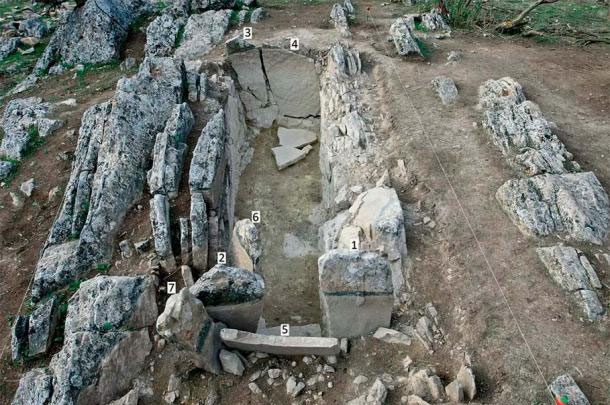On the colossal “Lovers’ Rock” La Pena de los Enamorados, a 5,000-year-old megalith has revealed a series of surprising secrets.
According to Ancient Origins, Lovers’ Rock La Pena de los Enamorados, also known as “The Sleeping Giant”, is a natural rock formation standing 884 meters tall, located in the Andalusia region of Spain, about 458 km southwest of Madrid.

The White Stone Tomb Piedras Blancas also serves as an astronomical observatory and an ancient temple – (Image: ANTIQUITY).
Above it, at the chest position of the “giant”, lies an ancient tomb known to locals as the “White Stone Tomb,” which has been famous for a long time; however, a recent excavation led by Professor of Prehistory Leonardo Garcia Sanjuan from the University of Seville (Spain) has unveiled shocking secrets about the “White Stone Tomb.”
Firstly, it is not merely an ancient burial site but also a form of primitive observatory, where ancient people observed celestial bodies, calculated calendars, and organized rituals.
A publication in the archaeological journal Antiquity states that the ancient White Stone Tomb on the “Lovers’ Rock” and every detail within the tomb were meticulously arranged with astronomical significance.
“Lovers’ Rock” La Pena de los Enamorados – (Image: ANCIENT ORIGINS).
The oldest megaliths of the tomb date back to around 3000 BC. Some ceramic grave goods from the same period were also placed in the tomb.
Scientists suspect that the skeletons were placed on a large flat stone platform and later pushed into a rear area of the platform after decomposition, where archaeologists found 45 teeth and 95 bone fragments.
Around 2500 BC, the tomb shows signs of being upgraded, with the addition of a pair of stone burial niches, possibly the resting place of a high-status couple.
Some time later, the tomb underwent significant changes again as new stones were added, sealing the entrance to the tomb. This renovation also included the remains of at least two children and three additional women. Thus, it was used in three distinct phases before being completely sealed from around 1950 to 1180 BC.
On another level, the stone circles and the positioning of the main tomb indicate it was indeed an ancient observatory, where prehistorical people used it to observe many important phenomena since around 3000 BC, during the Neolithic era in the region.
Some structures were pre-aligned to mark special days such as Spring Equinox, Autumn Equinox, Summer Solstice, and Winter Solstice…
All the floor slabs in the tomb were also carefully arranged to align with the sunrise on June 21, the Summer Solstice and the longest day of the year, indicating that this may have once been a ceremonial site for the sun deity.
The heaviest megalith was precisely placed to allow the sunlight to enter the back of the chamber on the day of the Summer Solstice. Another triangular stone was also embedded in the floor, oriented toward the rising sun.


















































